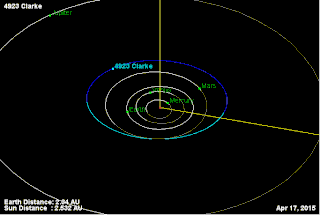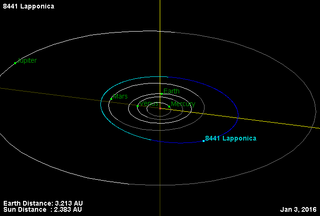Related Research Articles
3850 Peltier, provisional designation 1986 TK2, is a Florian asteroid and suspected interloper from the inner regions of the asteroid belt, approximately 4 kilometers in diameter. It was discovered on 7 October 1986, by American astronomer Edward Bowell at Lowell's Anderson Mesa Station, near Flagstaff, Arizona. The asteroid was named after American amateur astronomer Leslie Peltier.

4923 Clarke, provisional designation 1981 EO27, is a stony background asteroid from the inner regions of the asteroid belt, approximately 3.5 kilometers (2.2 miles) in diameter. It was discovered on 2 March 1981, by American astronomer Schelte Bus at the Siding Spring Observatory in Australia. The spheroidal S-type asteroid has a rotation period of 3.14 hours. It was named after British science fiction writer Arthur C. Clarke. On the same night, Schelte Bus also discovered 5020 Asimov.
3204 Lindgren, provisional designation 1978 RH, is a carbonaceous background asteroid from the outer regions of the asteroid belt, approximately 20 kilometers in diameter. It was discovered on 1 September 1978, by Soviet astronomer Nikolai Chernykh at the Crimean Astrophysical Observatory in Nauchnij, on the Crimean peninsula. The B-type asteroid has a rotation period of 5.6 hours. It was named after Swedish writer Astrid Lindgren.
4175 Billbaum, provisional designation 1985 GX, is a background asteroid from the central regions of the asteroid belt, approximately 9 kilometers in diameter. It was discovered on 15 April 1985, by American astronomer Edward Bowell at the Anderson Mesa Station of the Lowell Observatory near Flagstaff, Arizona. The uncommon L-type asteroid has a short rotation period of 2.73 hours and was named for American astronomer William A. Baum.
4446 Carolyn, provisional designation 1985 TT, is a dark Hildian asteroid from the outermost regions of the asteroid belt, approximately 30 kilometers in diameter. It was discovered on 15 October 1985, by American astronomer Edward Bowell at the Anderson Mesa Station of the Lowell Observatory near Flagstaff, Arizona, in the United States. The asteroid was named after American astronomer Carolyn Shoemaker. It has a longer than average rotation period of 40.9 hours.
5385 Kamenka, provisional designation 1975 TS3, is a background asteroid from the outer regions of the asteroid belt, approximately 16 kilometers (10 miles) in diameter. It was discovered on 3 October 1975, by Soviet astronomer Lyudmila Chernykh at the Crimean Astrophysical Observatory in Nauchnij, on the Crimean peninsula. The presumed C-type asteroid has a rotation period of 6.68 hours. It was named for the Ukrainian town of Kamianka.
9344 Klopstock, provisional designation 1991 RB4, is a background asteroid from the inner regions of the asteroid belt. It was discovered on 12 September 1991, by German astronomers Freimut Börngen and Lutz Schmadel at the Karl Schwarzschild Observatory in Tautenburg, Germany. Poor observational data suggests that the asteroid is one of the darkest known objects with a diameter of approximately 17 kilometers (11 miles), while it is also an assumed stony asteroid with a much smaller diameter. It has a rotation period of 5.84 hours and was named after German poet Friedrich Gottlieb Klopstock.

8441 Lapponica, provisional designation 4008 T-3, is a background asteroid from the Florian region of the inner asteroid belt, approximately 4.5 kilometers in diameter. It was discovered on 16 October 1977, by Ingrid and Cornelis van Houten at Leiden, and Tom Gehrels at Palomar Observatory in California. The L-type asteroid has a rotation period of 3.27 hours. It was named for the Bar-tailed godwit, a shorebird also known by its Latin name Limosa lapponica.
2004 Lexell, provisional designation 1973 SV2, is a stony Florian asteroid from the inner regions of the asteroid belt, approximately 7.5 kilometers in diameter. The asteroid was discovered on 22 September 1973, by Soviet astronomer Nikolai Chernykh at the Crimean Astrophysical Observatory in Nauchnij, on the Crimean peninsula, and later named for Swedish-Russian astronomer and mathematician Anders Johan Lexell.
3322 Lidiya, provisional designation 1975 XY1, is a stony Phocaea asteroid and potentially slow rotator from the inner regions of the asteroid belt, approximately 7 kilometers in diameter. It was discovered on 1 December 1975, by Soviet astronomer Tamara Smirnova at the Crimean Astrophysical Observatory in Nauchnij, on the Crimean peninsula. The asteroid was named after Russian aviator Lidiya Zvereva.

2606 Odessa, provisional designation 1976 GX2, is a background asteroid from the central regions of the asteroid belt, approximately 16 kilometers (10 miles) in diameter. It was discovered on 1 April 1976, by Soviet–Russian astronomer Nikolai Chernykh at the Crimean Astrophysical Observatory in Nauchnij, on the Crimean peninsula. The presumably metallic X- or M-type asteroid has an elongated shape and a rotation period of 8.24 hours. It was named for the Ukrainian city of Odesa.
3406 Omsk, provisional designation 1969 DA, is a background asteroid from the central regions of the asteroid belt, approximately 15 kilometers in diameter. It was discovered on 21 February 1969, by Soviet astronomer Bella Burnasheva at the Crimean Astrophysical Observatory on the Crimean peninsula in Nauchnij. The possibly metallic M/X-type asteroid has a rotation period of 7.3 hours. It was named for the Russian city of Omsk.
3953 Perth, provisional designation 1986 VB6, is a stony Florian asteroid from the inner regions of the asteroid belt, approximately 4.5 kilometers (2.8 mi) in diameter. It was discovered on 6 November 1986, by American astronomer Edward Bowell at the Anderson Mesa Station near Flagstaff, Arizona. The asteroid was named for the Australian Perth Observatory.
2975 Spahr, provisional designation 1970 AF1, is a bright background asteroid from the Flora region of the inner asteroid belt, approximately 6 kilometers (3.7 miles) in diameter. It was discovered on 8 January 1970, by Russian astronomers Hejno Potter and A. Lokalov at the Cerro El Roble Station near Santiago, Chile. The S- or A-type asteroid has a rotation period of 11.9 hours. It was named for Timothy Spahr, an American astronomer and former director of the Minor Planet Center.
4786 Tatianina, provisional designation 1985 PE2, is a bright background asteroid and synchronous binary system from the inner regions of the asteroid belt, approximately 3.4 kilometers (2.1 miles) in diameter. It was discovered on 13 August 1985, by Soviet astronomer Nikolai Chernykh at the Crimean Astrophysical Observatory in Nauchnij, on the Crimean peninsula. It was named after Tatiana Somova, a friend of the discoverer. The E-/Xc-subtype has a short rotation period of 2.9 hours. Its sub-kilometer minor-planet moon was discovered on 20 March 2006 and announced the following month.
2862 Vavilov, provisional designation 1977 JP, is a stony background asteroid and exceptionally slow rotator from the inner regions of the asteroid belt, approximately 7 kilometers in diameter. It was discovered on 15 May 1977, by Soviet astronomer Nikolai Chernykh at the Crimean Astrophysical Observatory in Nauchnij, on the Crimean peninsula. The asteroid was named after Russian plant geneticist Nikolai Vavilov and his physicist brother Sergey Ivanovich Vavilov.
3669 Vertinskij, provisional designation 1982 UO7, is a stony Florian asteroid from the inner regions of the asteroid belt, approximately 6.5 kilometers (4 miles) in diameter. It was discovered on 21 October 1982, by Soviet astronomer Lyudmila Karachkina at the Crimean Astrophysical Observatory in Nauchnij, on the Crimean peninsula. The S-type asteroid was named for Russian artist Alexander Vertinsky.
3703 Volkonskaya, provisional designation 1978 PU3, is a Vestian asteroid and asynchronous binary system from the inner regions of the asteroid belt, approximately 4 kilometers (2.5 miles) in diameter. It was discovered on 9 August 1978, by Soviet astronomers Lyudmila Chernykh and Nikolai Chernykh at the Crimean Astrophysical Observatory in Nauchnij, on the Crimean peninsula. It was named by the discoverers after the Russian princess Mariya Volkonskaya. The V-type asteroid has a rotation period of 3.2 hours. The discovery of its 1.4-kilometer minor-planet moon was announced in December 2005.
(11436) 1969 QR is a stony Florian asteroid from the inner regions of the asteroid belt, approximately 3.7 kilometers in diameter. It was discovered on 22 August 1969, by Czech astronomer Luboš Kohoutek at Bergedorf Observatory in Hamburg, Germany.
21501 Acevedo (provisional designation 1998 KC8) is a stony Florian asteroid from the inner regions of the asteroid belt, approximately 2.4 kilometers in diameter.
References
- 1 2 3 4 5 6 7 "4185 Phystech (1975 ED)". Minor Planet Center. Retrieved 27 April 2018.
- 1 2 3 4 "JPL Small-Body Database Browser: 4185 Phystech (1975 ED)" (2018-03-24 last obs.). Jet Propulsion Laboratory . Retrieved 27 April 2018.
- 1 2 "Small Bodies Data Ferret". Nesvorny HCM Asteroid Families V3.0. Archived from the original on 2 August 2017. Retrieved 27 April 2018.
- 1 2 "Asteroid 4185 Phystech – Proper Elements". AstDyS-2, Asteroids – Dynamic Site. Retrieved 29 October 2019.
- 1 2 3 4 5 6 7 8 "LCDB Data for (4185) Phystech". Asteroid Lightcurve Database (LCDB). Retrieved 27 April 2018.
- 1 2 3 Dykhuis, Melissa J.; Molnar, Lawrence A.; Gates, Christopher J.; Gonzales, Joshua A.; Huffman, Jared J.; Maat, Aaron R.; et al. (March 2016). "Efficient spin sense determination of Flora-region asteroids via the epoch method". Icarus. 267: 174–203. Bibcode:2016Icar..267..174D. doi:10.1016/j.icarus.2015.12.021 . Retrieved 27 April 2018.
- ↑ "MPC/MPO/MPS Archive". Minor Planet Center. Retrieved 27 April 2018.